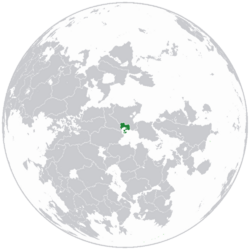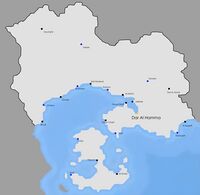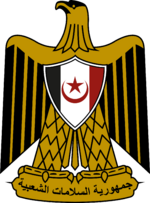Salamat: Difference between revisions
No edit summary |
No edit summary |
||
| Line 144: | Line 144: | ||
}} | }} | ||
Salamat is a country located in North [[Thrismari]], on the planet [[Anteria]]. It is bordered by the [[Anchor Lake]] to the south, the Khaliwi Mountains to the north and [[Yryel]] to the west. | Salamat is a country located in North [[Thrismari]], on the planet [[Anteria]]. It is bordered by the [[Anchor Lake]] to the south, the Khaliwi Mountains and [[Madura]] to the north and [[Yryel]] to the west. | ||
== History == | == History == | ||
Revision as of 07:41, 18 June 2022
People's Democratic Republic of Salamat جمهورية السلامات الديمقراطية الشعبية (Arabic) | |
|---|---|
| Motto: "لا اله الا الله محمد رسول الله" "There is no god but Allah and Muhammad is his messenger" | |
| Anthem: "والله زمان يا سلاحي" I swear to God it's time, my weapon | |
 Location of Salamat in Anteria. | |
 Major cities of Salamat. | |
| Capital and | Dar Al Hamma |
| Official languages | Arabic |
| Ethnic groups (2016) | Arabic 95% Hebrew 3% Madurese 2% |
| Religion (2016) | Sunni Islam 96% (official) Dharmaism 3% Judaism 1% |
| Demonym(s) | Salamati |
| Government | Unitary semi-presidential republic |
• President | Abd-El Rahman Jarruf |
• Prime Minister | Anas Zitoune |
| Legislature | Parliament |
| National Council | |
| National Assembly of Salamat | |
| Establishment | |
• Conquest of the area by Islamic Armies | 690 CE |
• Creation of the Salimid Caliphate | 1450 CE |
• Fall of the Salimid Caliphate | 1820 CE |
• Colonization by Riamo | March 4, 1828 |
• Start of the Salamati Independence War | October 9 1964 |
• End of the Salamati Independence War | September 3 1969 |
• Coup d'Etat of Jalil Al Kharrabi | May 16 1977 |
• Start of the Salamati Civil War | April 10 1993 |
• End of the Salamati Civil War | January 29 1999 |
| Population | |
• 2016 census | 28,439,211 |
| GDP (PPP) | 2014 estimate |
• Total | $320,373 billion |
• Per capita | $11,265 |
| GDP (nominal) | 2014 estimate |
• Total | $118,421 billion |
• Per capita | $4,164 |
| Gini (2012) | 28.2 low |
| HDI (2019) | high |
| Currency | Salamati Dinar (SLD) |
| Time zone | UTC-1 (SLT) |
| Antipodes | North of Lesser Velutaria |
| Driving side | right |
| Calling code | +395 |
| ISO 3166 code | SLM |
| Internet TLD | .sl |
Salamat is a country located in North Thrismari, on the planet Anteria. It is bordered by the Anchor Lake to the south, the Khaliwi Mountains and Madura to the north and Yryel to the west.
History
Islamic Conquest and Early History
The area where Salamat is now established was pretty quiet and there were only some nomad tribes living there. In 685 CE, General Ghali Ibn Karim ordered his troops to explore further up north-east to the actual Anchor Lake and conquer those lands. The first soldiers arrived in ~689 CE, and started converting the local tribes to Islam, with little resistance from the tribes against conversion. The Anchor Island was uninhabited at that time and was conquered in 712 CE. Over time, it was starting to get inhabited by the Arabs and they eventually created the Ankur Caliphate in 770 CE, which was a vassal state of a much bigger Arabic Caliphate. The Caliphate's capital was Hayyum, on the west coast of the Anchor Island and it was home to many Arab astronomers of the 9th, 10th and 11th century. The Ankur Caliphate was annexed by the Arabic Caliphate in 1296 CE.
Salimid Caliphate
The Salimid Caliphate was established in ~1445 CE, with the first ruler being Ahmad I. The Caliphate was a marking point in the Salamati history, for creating and developing infrastructures like ports and cities, establishing trade routes and boosting the economy. The Salimid Caliphate had numerous capitals, including Dar Al Hamma (1445-1587/1802-1820), Ghafun (1587-1644), Asal (1644-1696), Douara (1696-1738) and Ankur (1738-1802). These cities benefitted from special treatment and better infrastructures than the other major cities that weren't capitals. The Salimid Caliphate counts a total of 38 caliphs from the foundation to the collapse of the Caliphate. The most famous is Khaliq III (1495-1567/Reign from 1540-1563), who boosted the Salimid economy by opening new trade routes and developing the cotton industry, and led a great war against some Christian insurgents in 1556, which he won. This war permitted him to gain more popularity from the people, but fearing fanatism, jealousy and abandonment of Islam for a special cult dedicated to him made him step down from the throne in April 1563. He died 4 years later. Another famous caliph was Tariq I (1549-1616/Reign from 1599-1615), particularly known for his massacres and deportations, the most famous being the eradication of the Khaliwi Tribe in June-September 1605, after resisting against the authorities who tried to exploit them to farm cotton. As a result, the tribe was erased in a little less than 3 months. He also ordered the eradication of 4 other tribes who also refused to farm cotton for a total of 180,000 dead people under his reign. Tariq I lost his post of Caliph in February 1615, was judged in June of the same year and condemned to the death penalty as a result of his exactions. He was executed on January 26th 1616. The Caliphate collapsed in 1820 CE, due to lack of trade routes, an aging infrastructure and bad life quality. The Caliphate was divided in 3 provinces after the dissolution.
Riamese Colonization
The Riamese first set foot on Salamati soil on March 4 1828 at Dar Al Hamma. A battle was engaged between the Dar Al Hamma Province and the Riamese on the 5th of March and resulted in a Riamese victory on May 20th. Most tribes were friendly with the Riamese, eventually forming an alliance and making them prevail over the rebel tribes. The rebels were led by Abd Al Fattah al Salimat, known for the battle of Ghafun (June 27th 1830-August 1st 1830), the battle of Sidi Kherridj (January 8th 1831-February 12th 1831) and the battle of Mansujah (March 10th 1831-March 25th 1831). After more than 10 years of active resistance, Abd Al Fattah Al Salimat surrenders in 1843. The resistance still went on and fought 2 more years before being destroyed. The Riamese first established the trade dependency of Salamat and reorganized the territory in 1848 and also appointed leaders of some of the friendly tribes as governors of the province. The governors had to pay taxes to the Riamese Empire in exchange of trade and land protection. There were also some cultural mixing between the Riamese and the Salamati, forming a mixed ruling class for decision-making and creating a false sentiment of respect. The Riamese then started exploiting cotton resources in the mid-19th century, creating underpaid jobs for the locals. If the locals refused, the Riamese would slowly take their goods until they accept to farm. Due to the lack of workers, the Riamese sent Gassasinians in Salamat to farm cotton. The first Gassasinians arrived in 1878 in Hani, and the mixing between Gassasinians and Salamatis,the use of the same language and the practice of the same religion created a friendly rivalry between Gassasinians and Salamatis, and to this day, there are an estimated 110,000 Gassasinians in Salamat, mostly of Christian and Shia Muslim confession. The poor living conditions of the Salamati was a reason for some to emigrate to Riamo in order to live decently. This emigration started in 1914 and ended in the mid-1920s. The consequences of the emigration was the creation of a Salamati intellectual class, who later advocated for the independence of Salamat. An intellectual named Anwar Al Harrani created the Salamati Star party in 1931, an independentist party who will later be involved in many revolts of the people, most notably the Jurhan Revolt on May 9 1934, where an estimated 30 000 Salamatis protested on the street with Salamati independentist flags, this pissed off the Riamese authorities who opened fire on the protesters. Some furious protesters, in response to this massacre, killed Riamese civilians. A small group of Riamese civilians were with the military and killed innocent Salamatis. Historians estimate that at least 7 500 Salamatis, 425 Riamese (civilians) and 200 soldiers were killed during this revolt and believe it was one of the reasons for an independence war.

